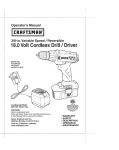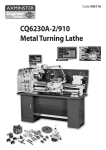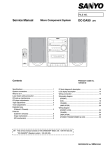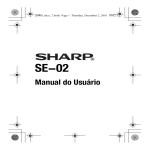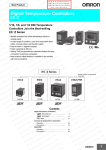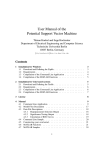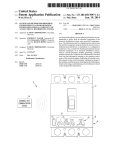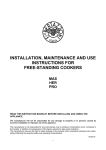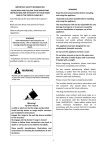Download www . ElectricalPartManuals . com
Transcript
om .E lec tri ca lP ar tM an ua ls PTS 5 User Manual .c SIEMENS ww w 18-838-728-502 Issue 3 888.902.6111 | www.intellirentco.com om Introduction Safety Information .c Table of Contents ............................................................. General Controls and Indicators Test Preparation . . . . .. .. . . ... ... . . .... . .......... ... Short Time Pickup Test Ground Fault Pickup Test Instantaneous Pickup Test . . ... . .. . . . . . . .. Zone Selective Interlock Tests Thermal Memory Testing Testing the STili Actuator . . . .. . . . .. .... .. . . . . . . .. . ..... ........... . . . . . . ......... ............. ... . . . . . . . .. . ..... . . . . . . ... . . . ... ....... . . . ............. ......... . . . . . . . . . . . ........ .................. .. . . . . . .. . ........... . . . . . . .... . ...... . .............. . . . . . . .............. . . . .. .. . . ... .... ...... . . . . . . ..... . ... . ................. .................... ............ . . . . .. . . . . . ...... . .. . . ... . . . . . ....... . . ............ ...... . ..... .. .. . .. .... . . . . . . ....... . . . . . . ........ ..... .... . . . . . . .............. . ...... . . 15 16 17 18 21 ...... ....... ........ .. . . .................. . . . . . . . . . . . . . . . . .................... . . . . . . . . . . . . . .... . . . . . . . . . . . ... . . . ... . 11 13 14 .............. ........... . .. . .4 8 10 ......... . . . . ............. .. 2 .3 . . . . . . . . . ..... .. ....... . . . . . . . ........................ .......... .. . . . . . . . . .. . . . . . . . . . . . ..... ..... Repair of Static Trip Devices .. . . . .... . . . . . . . . ....... .......... . . . ........ Calibration .. . .................... .................... Long Time Delay Test Short Time Delay Test Ground Fault Time Delay Test ....... ar tM an ua ls ...... Long Time Pickup Test . ........ 1 ... . ........ 23 ........... . . 25 ........ 26 . . . . . . . ....... lP THESE INSTRUCTIONS DO NOT PURPORT TO COVER ALL DETAILS OR VARIATIONS IN EQUIPMENT. NOR TO PROVIDE FOR EVERY POSSIBLE CONTINGENCY TO BE MET IN CONNECTION WITH INSTALLATION. OPERATION OR MAINTENANCE. SHOULD FURTHER INFORMATION BE DESIRED OR SHOULD PARTICULAR PROBLEMS ARISE WHICH ARE NOT COVERED SUFFICIENTLY FOR THE PURCHASERS'S PURPOSES. THE MATTER ca SHOULD BE REFERRED TO THE LOCAL SIEMENS SALES OFFICE. THE CONTENTS OF THIS INSTRUCTION MANUAL SHAll NOT BECOME PART OF OR MODIFY ANY PRIOR OR ww w .E lec tri EXISTING AGREEMENT. COMMITMENT OR RELATIONSHIP. THE SALES CONTRACT CONTAINS THE ENTIRE OBLIGATION OF SIEMENS. THE WARRANTY CONTAINED IN THE CONTRACT BETWEEN THE PARTIES IS THE SOLE WARRANTY OF SIEMENS. ANY STATEMENTS CONTINUED HEREIN DO NOT CREATE NEW WARRANTIES OR MODIFY THE EXISTING WARRANTY. 888.902.6111 | www.intellirentco.com .c THIS EQUIPMENT CONTAINS HAZARDOUS VOLTAGES. DEATH, SERIOUS PERSONAL INJURY, OR PROPERTY DAMAGE CAN RESULT IF SAFETY INSTRUCTIONS ARE NOT FOLLOWED. ONLY QUALIFIED PERSONNEL SHOULD WORK ON OR AROUND THIS om Introduction ar tM an ua ls EQUIPMENT AFTER BECOMING THOROUGHLY FAMILIAR WITH ALL WARNINGS AND SAFETY NOTICES CONTAINED HEREIN. THE SUCCESSFUL AND SAFE OPERATION OF THIS EQUIPMENT IS DEPENDENT UPON PROPER HANDLING, INSTALLATION AND OPERATION. QUALIFIED PERSON FOR THE PURPOSE OF THIS MANUAL AND PRODUCT LABELS, A QUALIFIED PERSON IS ONE WHO IS FAMILIAR WITH THE INSTALLATION, CONSTRUCTION AND OPERATION OF THE EQUIPMENT. AND THE HAZARDS INVOLVED. IN ADDITION, HE OR SHE HAS THE FOLLOWING QUALIFICATIONS: a) b) c) I s trained and authorized to energize, de·energize. clear, ground a n d tag circuits and equipmnnt in accordance with established safety practices. Is trainc.o in the proper care and use of protective equipment such as rubber gloves, hard hat, safety glasses or face shields, flash clothing, etc., in accordance with established safety practices. Is trained In rendering first aid. DANGER lP FOR THE PURPOSE OF THIS MANUAL AND PRODUCT LABELS, DANGER INDICATES AN IMMINENTLY HAZARDOUS SITUATION WHICH, IF NOT AVOIDED, WILL RESULT IN DEATH OR SERIOUS INJURY. WARNING ww w .E lec tri ca FOR THE PURPOSE OF THIS MANUAL AND PRODUCT LABELS, WARNING INDICATES A POTENTIALLY HAZARDOUS SITUATION WHICH, IF NOT AVOIDED. COULD RESULT IN DEATH OR SERIOUS INJURY. 1 888.902.6111 | www.intellirentco.com om AWARNING ar tM an ua ls High Speed MOving Parts .c Safety Information Can cause death or serious injury Discharge the springs before attempting to perform any inspection or adjustment of the circuit breaker operating mechanism. Keep hands clear of the mechanism if exercising the circuit breaker during the test lP Hazardous voltage Will cause death, serious personal injury, andfor property damage. ca Only qualified personnel should work on this equipment. after becoming thoroughly familiar with all wamings, safety notices. and maintenance procedures containe<t tri herein and on the devices. .E lec Tum off power before working on this equipment. The successful and safe operation of thIs equipment is dependant on proper handling, installation, operation, and maintenance. The use of a ground fault circuit interrupter (GFCI) protected receptacle is strongly recommended. This protection can be provided in the field by the use of an extension cord with ww w an integrated GFCI device where a GFCI protected receptacle Is not available. 2 888.902.6111 | www.intellirentco.com om .c General The Portable Test Set (PTS 5) is designed for performIng secondary InjectIon testing of the Stalic Trip III (STili) overcurrent tripping system utilized on the Rl breaker. The system is packaged in a selkontained briefcase and requires 120 V ae to operate. ar tM an ua ls The PTS 5 contains a microprocessor controlled constant current source which enables rapid verification of the perionnance of the STilI. The desIred test current may be directly entered with a numeric keypad for ease of test configuration. The serf contained. automatically controlled digital limer allows simple verification of the lime-current tripping characteristics. The system also provides a regulated DC voltage to allow funclional testing of the tripping actuator. The incoming power Is converted to a filtered and regulated de bus. From this de supply, the testing current is generated using a current amplifier regulated by the microprocessor and a precision digital to analog converter. This provides for stable test culTent even when the incoming line voltage fluctuates. This feature helps to eliminate discrepancies that may occur if a line-derived cUlTent source is used for testing. The test current is applied to the current Inputs on the STIli, eilher by a jumper cable for orr-breaker testing, or altematively, the STili may be connected to a terminal block on the face of the PTS 5 for standalone testing, The STII' connection also provides for the trip feedback that stops the clock and the test current automatically. The scope of this manual covers the operation of the PTS 5. Additional information on the STili may be found in publicaUon SGIM-3118C. Additional Information on the RL breaker may be found In publication SGIM-30660. These documents are available from the nearest Siemens sales office, and should be consulted should any questions arise to the function of the STili or RL breaker. or earlier trip lP Note: The PTS 5 d oe s not support the Static TrIp 11 units associated with ww w .E lec tri ca the LA b reaker. It Is necessary to utilize a PTS 4 to test these legacy trip units. 3 888.902.6111 | www.intellirentco.com om Controls and Indicators (refer to Figure 1 for location) 1) ww w .E lec tri ca lP ar tM an ua ls .c POWER 120 VAC and SWITCH: AUach Ihe power supply cord here. The SWITCH applies power to the unit. 2) INPUT OVERCURRENT PROTECTION: Provides protection to the circuit in the event of internal failure. Should this breaker trip repeatedly, the unit likely has an internal fault and requires service. 3) CURRENT OUTPUT SHUNT: Provides a test point for connecting an external ammeter when performing calibration testing. The white shorting plug must be inserted in the jacks when an eldernal ammeter is not connected, or else the current output will not function. 4) ACTUATOR TEST: Provides a controlled low vortage de source, to be used only for testing the STili tripping actuator. 5) OUTPUT OVERCURRENT PROTECTION: Provides protection against short cIrcuits on the output. 6) STATIC TRIP'" (terminal strip): Attach the fanning strip from a STIli being tested without a circuit breaker here. Note: Pin 1 is the end of the fanning strip opposite the end where the wire bundle is secured. The peg adjacent to Pin 1 serves to block the fanning strip from being attached backwards. Refer to Figure 3 for proper attachment of the fanning strip. 7) OUTPUT (15-pln Molex connector): Attach the test cable here. The test cable is used for tests where the STili is attached to a circuit breaker. See Figure 2 which shows how to properly attach the test cable. 8) STATIC TRIP III (2S-pin DB connector): Attach the adapter cable to this connector. The other end of the adapter cable goes to the 9-pin and 15-pin connectors on the fronl of the STilI. This cable Is only necessary for performing' the Long Time, Short Time, and Ground Fault Pickup tests. 9) Indicator lights: D LTPU (amber) lights when the STili is in Long Time Pickup mode. D STPU (amber) lights when the STili is in Short Time Pickup mode. D ALARM (red) lights when the test time duration is exceeded, or if there is excessive current on the test leads (caused by a ground fault or short circuit). o OVLD (red) lights when the STili bips out In the Long Time Delay test or Short Time Delay test. o POWER (green) lights to indicate the unit is turned on. 10} Display: Provides information to the user about the test In progress. 11) Keypad: Allows user to select the desired test routine, choose parameters for the test. as welf as start and stop the test routine. The keys have the following functions: o 0-9: Entry 01 the desired numeric value for the test. The decimal point is implied, so to enter values less than one, a leading zero must be included. For example, to enter the value 0.275 A, the keys 0 2 7 5 must be pressed. o �: Backspace, clears incorrect numeric entries. D 01: Selects the application of current to Phase 1 of the trip unit. o 02: Selects the application of current to Phase 2 of the trip unit. o 03: Selects the application of current to Phase 3 of the trip unit. o PREV: Selects the previous test from the list at the top of the display. o NEXT: Selects the next test from the list at the top of the display. o START: Slarts Ihe selected lest o STOP: Stops the selected test. D ENTER: Confinns the entered value for the test parameter. o (blank key): This key is used to enter the calibration mode. 12) Storage compartment: The test leads are stored in this compartment. To open the compartment. press the latches. To secure the compartment, press the latch buttons again, 4 888.902.6111 | www.intellirentco.com ww om w .E lec tri ca lP ar tM an ua ls .c Figure 1 Panel Layout 5 888.902.6111 | www.intellirentco.com ww om w .E lec tri ca lP ar tM an ua ls .c Figure 2 Attachment of the test cable to an STili mounted on a breaker .. 6 888.902.6111 | www.intellirentco.com om 5 ww w .E lec tri ca lP ar tM an ua ls .c Figure 3 Attachment of an STili directly to the PTS 7 888.902.6111 | www.intellirentco.com om " DANGER Hazardous voltage .c Test Preparation ar tM an ua ls Will cause death. serious personal InJury, end/or property damage. Only qualified personnel should wori<. on this equipment, after becomIng thoroughly famm ar with all warnings, safety notices, and maintenance procedures contained hereIn and on the devices. Tum of( power before working on this equlpmenl. The successful and safe op er ation or this equipment is dependant on proper hand l ing , Inslallation, operation, and maintenance. tri ca lP Make the following preparations before the test: o The breaker must be racked off the power bus'; either to the TEST or DISCONNECT pos�lon. o If the breaker is completely withdrawn from the cubicle (i,B. it Is being bench tesled), then rotate the racking screw to the TEST position, to allow the breaker to be charged and closed. o If the STili is completely removed from a breaker, then attach the fanning strip to the termInal block on the front panel per Figure 3. If the STili is stili attached to the breaker, connect the leads per Figure 2 to the test connector on the front of the breaker. o Plug the 251>in connector of the adapter cable into the 08-25 connector on the front panel (item 8 in Figure 1.) Plug the g pin and 15-pin connectors on the adapter cable into - .E lec the sockets on the front of the STIli (detach any existing cables from these connectors first). Note: This cable is only needed for the Long Time, Short Time, and Ground Pickup tests. o Plug the power cord into the POWER connector on the front panel, and into a properly grounded, 120 V ac receptacle. Tum on the switch located adjacent to the POWER Long connector. The unit should perform a self test and then display the following: Time Pickup ww w Phase: 1 I: O.27SA Slatus: Idle I The lower right corner of the display wfll show a rotating marker. This indicates that the microprocessor is running normally. The display will go to screen saver, which is a • symbol traveling across the display, should the unit be left Idle for an extended period of time. Make a note of the front panel settings on the STili, so that the STili can be returned to its origInal state after the test. Set the STili configuration switches as follows for all tests, unless 2 otherwise noted: Thermal Memory: OUT; Short time 1 t: OUT; Zone Interlock: OUT. 8 888.902.6111 | www.intellirentco.com om ar tM an ua ls Set the STill dials as follows (Ignore any that are not present on the unit under test): long TIme Setting: 0.5 x sensor long Time Delay: 3,5 s Instantaneous Pickup: 15 x sensor Short Time Pickup: 12 x LT setting Short Time Delay: 0.40 s Ground Fault PIckup: 20% Ground Fault Delay: 0.40 s .c Long Time Pickup (LTPU) Test Ensure the adapter cable is connected for thIs test. Press the START button. Accept the default start value of 0.275 A by pressing ENTER. The. system willlnjeci current into Phase 1 of the STili. and will automatically increase the current until one of the following occurs: o If the STili goes into LTPU, the test will stop, the display will show the current value at which LTPU was achieved, and the LTPU light will Illuminate. Note that the time is irrelevant for this test, as this test only determines the minimum pickup current value for the long Time element o If the operator pushes the STOP button before the test finishes, the test will stop, and the display will indicate �Stopped". o If the current achieves 120% ot"its initial value, and the STili does not go Into l TPU, the test wlU stop, the display will indicate ·Fail�, and the ALARM light will tum on. It may require more than a minute for the STili to achieve LTPU. The pickup point may vary from dial setting. As shown on the table 'below, with the LTPU setting at 0.50, the STili should have picked up between 0.250 and 0.3QO A (or -0, +20%). +20% to -0% of the To test another phase, press the STOP button to return to the "Idle" status, and then press 02 or as desired. Observe that the display Indicates the selected phase. Then press START and then ENTER to test the next phase. lP 03 Sel1ina long Time Pickup Current tri LTPU ca Test (he remaining points on the Long Time Setting dial. In each case, the STili should achieve LTPU within the parameters listed below. To speed up the testing In the higher ranges, a starting value closer to the minimum may be keyed In after pressing the START buHon, Press ENTER to load the value and s tart the test Minimum Maximum 0.300 0.250 0275 0.330 0.60 0.300 0.360 .E lec 0.50 0.55 0.325 0.390 0.350 0.420 0.75 0.375 0.450 0.80 0.400 0.480 0.85 0.425 0.510 0.90 0.450 0.540 0.95 0.475 0.570 w 0.65 0.70 0.500 0.600 1.00 ww Short TIme PIckup (STPU) Test (only if equipped) 9 888.902.6111 | www.intellirentco.com om ar tM an ua ls .c Set the STIli dials as follows (ignore any that are not present on the unit under test): Long Time Setting: 0.5 x sensor (very importantl) Long Time Delay: 30 s Instantaneous Pickup: 15 x sensor Short TIme Pickup: 2 x LT setting Shol1 Time Delay: 0.40 s Ground Fault Pickup: 20% Ground Fault Delay: 0.40 s Ensure that the adapter cable is connected for this test. Press the NEXT button to select �Short Time Pickup· mode. Press the START button. Accept the default start value of 0.500 A by pressing ENTER. The system will inject current into Phase 1 of the STili. and will automatically increase the current until one of the following occurs: o If the STIli goes into STPU, the test will stop. the display will show the current value at which STPU was achieved, and the STPU light will illuminate Note that the time is irrelevant for this test, as this test only determines the minimum pickup current value for the Short Time element. o If the operator pushes the STOP button before the test finishes. the test will stop, and the display will indicate "Stopped". o If the current achieves 120% of its initial value, or the test persists for one minute, and the STili does not go into STPU, the test will stop, the display will indicate wFailM, and the ALARM light will turn on. Note that the 'long Time Pickup· light on the STili will tum on during this test. As shown on the table below, with the STPU setting at 2 x LT. and the LT setting at 0.5 x sensor, the STili should have picked up between 0.500 and 0.600 A (or -0, +20%� lP To test another phase, press the STOP button to return to the -Idle" status, and then press 02 or 0'3 as desired. Observe that the display indicates the selected phase. Then press START and ww w .E lec tri ca then ENTER to test the next phase. 10 888.902.6111 | www.intellirentco.com om .c Test the remaining points on the Short Time Pickup dial. In each case, the STili should achieve STPU within the parameters listed below. To speed up the testing in the higher ranges, a starting value closer to the minimum may be keyed in after pressing the START button. Press ENTER to load the value and start the test. Short TIme Pickup Current Setting Minimum Maximum 2 0.500 0.600 3 0.750 0.900 4 1.000 1.200 5 1.250 1.500 6 1.500 1.800 7 1.750 2.100 8 2.000 2.400 12 3.000 3.600 ar tM an ua ls STPU ww w .E lec tri ca lP Note: Ensure the Long Time Setting is 0.5 for this test. 11 888.902.6111 | www.intellirentco.com om .c Ground Fault Pickup (GFPU) Test (only if equipped) Set the STili dials as follows (ignore any thai are not present on the unit under test): Long Time Setting: 0.5 x sensor long Time Delay: 30 s Ground Fault Pickup: 20% Ground Fault Delay: 0.40 s ar tM an ua ls Instantaneous Pickup: 15 x sensor Short Time Pickup: 2 x lT setting Short Time Delay: 0.40 s Ensure that the adapter cable is connected for this test. Press the NEXT bulton to select "Ground Pickup· mode. Press the START button. Accept the default start value of O. 1 00 A by pressing ENTER. The system wlll inject current into the Ground element of the STili, and will automatically increase the current until one of the following occurs: o If the STili goes into GFPU, the test will stop, the display will show the current value at which GFPU was achieved, and the GFPU light will Illuminate. Note that the time is o o irrelevant for this test, as this test only detennlnes Ihe minimum pickup current value for the Short Time element. If the operator pushes the STOP button before the test finishes, the test will stop, and the display will indicate MStopped-. If the current achieves 120% of its initial value, and the S1111 does not go into GFPU, the test will stop, the displa�· will Indicate -':all", and the AlARM light will tum on. lP As shown on the lable below, with the GPU setting at 20%, the STili should have picked up between 0.090 and 0.110 A (or :1:1 O%� Note that since the STili shares the same output signal and indicator light for Short Time and Ground Fault pickups, that the display will read ·STPU" for the slatus, and the STPU status1ight on the PTS 5 will tum on, even though the STili really achieved GFPU. Note that the Phase buttons are not used for this test. ca Test the remaining pOints on the Ground Fault Pickup dial. In each case, the STIli shoulq achieve GFPU within the parameters listed below. To speed up the testing in the hlgher"ianges, a starting value closer to the minimum may be keyed In after pressing the START button� Press GFPU Setting tri ENTER to load the value and start the test. Ground Pickup Current Minimum Maximum 50% 0.090 0.135 0.180 0.225 0.110 0.165 0.220 0.275 60% 0.270 0.330 ww w .E lec 20% 30% 40% 12 888.902.6111 | www.intellirentco.com Set the STili dials as follows (Ignore any that are not present on the unit under test): long Time Setting: 1.0 x sensor Short Time Delay: OAO 5 Ground Fault Pickup: 20% Ground Fault Delay: 0.40 s om ar tM an ua ls Long TIme De/ay: 30 5 Instantaneous Pickup: 2 x sensor Short Time Pickup: 12 x L T setting .c Instantaneous Pickup (IPU) Test (only if equipped) Note that by nature of the Instantaneous function, pIckup causes a trip. It is not necessary to connect the adapter cable to the 9-pin and 15-pln ports for this test. Press the NEXT button to select "'nst Pickup" mode. Press the START button. Accept the default start value of 1.000 A by pressing ENTER. The system will inject current into the Phase 1 element of the STili, and will automatically increase the current until one of the following occurs: o If the STIli goes into IPU, the test will stop, and the display will show the current value at o o which IPU was achieved. Note that the time is irrelevant for this test. as this test only determines the minimum pickup current value for the Short Time elemenl. If the operator pushes the STOP button before the test finishes, the test will stop, and the display will indicate ·Slopped-. If the current achieves 150% of its initial value (up to 10 A max.), and the STili does not go into IPU, the test will stop, the display will indicate "Fail", and the ALARM light will turn on. As shown on the table below, with the IPU setting at 2 x, the STili should have picked up lP between 1.000 and 1.200 A (or ·0, +20%� Note that the STili does not have an indicator for Instantaneous Pickup, due to the nature of the function. The STili will show "SHORT CIRCUlr In the window upon successful completion of the test. To test another phase. press the STOFI buHon to return to the "Idle" status. and then press 02 or 03 as desired. Observe that the display indicates the selected phase. Then press START and ca then ENTER to test the next phase. Test the remaining points on the Instantaneous Pickup dial. In each case, the STili should tri achieve IPU within the parameters listed below. To s� up the testing In the higher ranges, a starting value closer to the minimum may be keyed in after pressing the START button. Press ENTER to load the value and start the tesl. The 12x and 15x ranges can only be verified for .E lec function at the maximum allowed value. The system cannot sustain sufficient current at these magnitudes long enough to effectively determine the trip point. IPU SeHing Instantaneous Pickup Current Minimum Maximum 2 1.000 1.200 4 2.000 2.400 6 3.000 3.600 8 4.000 4.800 verify function @ 6A 12 v erify function @. 7.2A ww w 15 888.902.6111 | www.intellirentco.com om .c Long Time Delay (LTD) Test Set the STili dials as follows (ignore any tha� are not present on the unit under test): Long Time Setting: 0.5 x sensor long Time Delay: 3,5 s ar tM an ua ls Instantaneous Pickup: 15 x sensor Short Time Pickup: 12 x LT setting Short T1me Oelay: 0.40 s Ground Fault Pickup: 20% Ground Fault Delay: 0.40 s Press the NEXT button to select �Long TIme Oelay" mode. Press the START buHon. Accept the default start value of 1.500 A by pressing ENTER. This value is the easiest one to use, because at this current value. the time delays """;11 equal the dial setting. The system will inject current into the Phase 1 element of the STIli, and will automatically maintain the current at the preset value, until one of the following occurs: o o o If the STlIIlrips, the test will stop, and the display wll show the current and elapsed time that the trip occurred. If the operator pushes the STOP button before the test finishes, the test will stop, and the display will indicate "Stopped". If the current persists for more than 7 minutes (1 minute, if the current is greater than 1 A), and the STili does not trip, the test will stop, the display will indicate "Fall", and the AlARM Itghl will tum on. lP As shown on the table below, with the LTO setting at 3.5 S, the STili should have tripped between 3.500 s and 5.250 s. when 1.5 A is applied. The STili will show 'OVERLOAD' in the window upon successful completion of the test. If the STili is attached to the breaker, and the breaker is dosed, it should trip at the end of the delay. To test another phase, press the STOP button to return to the "Idle" status, and then press 02 or 133 as desired. Observe that the display indicates the selected phase. Then press START and ca then ENTER to test the next phase. .E lec tri Test the remaining points on the long Time Delay dial. In each case, the STili should trip the breaker within the parameters listed below. Other combinations of time delay and pickup current may be tested If desired, however, the expected trip time will need to be detennined from the time-current culVe. Press ENTER to load the value and start the tesl Note that at currents above 2 A, long duration testing is rather stressful on the STili; avoid repeated or prolonged testing at the high ranges. LTD SeW"" Lono TIme Delay (s) Minimum Maximum 3.5 3.500 5.250 6 6.000 9.000 10 10.000 15.000 17 17.000 25.500 30 30.000 45.000 ww w This table is valid for Input current of 1.5 A. with a Long Time Setting of 0.5 x sensor. 14 888.902.6111 | www.intellirentco.com Set the STili dials as follows (ignore any lhal are not present on the unit under test): Long TIme Setting: 0.5 x sensor Long lime Delay: 30 s Ground Fault Pickup: 20% Ground Fault Delay: 0.40 s om ar tM an ua ls Instantaneous Pickup: 15 x sensor Short Time Pickup: 2 x lT setting Short Time Delay: 0.40 s .c Short Time Delay (STD) Test (only If equipped) Press the NEXT button to select �Short Time Delay" mode. Press the START button. Accept Ihe default start value of 1.000 A by pressing ENTER. The system will Inject current into the Phase 1 element of the STili, end will automatically maIntain the current at the preset value, until one of the following occurs: o If the STili trips, the test will stop, and the display will show the current and elapsed time o o that the trip occurred. If the operator pushes the STOP button before the test finishes, the test will stop, and the display will indicate "Stoppedw• If the current persists for more than 1 minute, If the current Is greater than 1 A, and the STili does not trip, the test will stop, the display will indicate -FaU", and the ALARM light will tum on. on the table below, with the STO setting at 0.40 s, the STili should have tripped between 0,080 s and 0.180 s, wnen 1.0 A (or greater) is applied. The STili will show "SHORT CIRCUlr in the window upon successful completion of the test If the ST111 is attached to the breaker, and the breaker is closed, It should bip at the end of the delay. lP As shown ca To test another phase. press the STOP buHon to return to the -Idle- status, and then press 02 or 03 as desired. Observe Ihat the display indicates the selected phase. Then press START and then ENTER to test the next phase. STD tri Test the remaining points on the Short TllTle Delay dial. In each case, the STili should trip the breaker within the parameters listed-below. Other combinations of time delay, bip current, and Short time ft mode may be tested If desired, however, the expected bip time will need to be determined from the time-current curve. Press ENTER to load the value and start the test. Short TIme DelaY (s) Minimum Maximum 0.08 0.080 0.180 0.15 0.150 0.225 0.22 0.220 0.330 0.30 0.300 0.400 0.40 0.400 0.500 .E lec SeHino ww w This table is valid for Long Time Pickup setting of 0.5 x sen'sar, with a Short Time Setting of 2 x Long Time, at currents greater than 1 A. 15 888.902.6111 | www.intellirentco.com om .c Ground Fault Time Delay (GFTD) Test (only if equipped) Set the STIli dials as follows (ignore any that are not present on the unit under test): Long Time Setting: 0.5 x sensor Long Time Delay: 30 5 Instantaneous Pickup: 15 x sensor Ground Fault Pickup: 20% Ground Fault Delay: 0.10 s ar tM an ua ls Short Time Pickup: 12 x L T setting Short Tm& Delay: 0.40 s Press the NEXT button to select �Ground Time Delay" mode. Press the START button. Accept the default start value of 0.500 A by pressing ENTER. The system will inject current into the Ground element of the STili. and will automatically maintain the current at the preset value, until one of the follo'Ning occurs: o If the STill trips, the test will stop, and the display will show the curren t and elapsed time that the trip occurred. o If the operator pushes the STOP button before the test finishes, the test will stop. and the display will indicate "Stopped". o If the current persists for more than 7 minutes, and the STili does not trip, the test will stop, the display will indicate '!'FaU·, and the ALARM light will tum on. \ As shown on the table below, with the GFTD setting at 0.10 s, the STIli should have tripped between 0.100 s and 0.200 s, when 0 . 5 A is applied. The STili will show "GROUND FAUL1" in the window upon successful completion of the test. If the STIU is attached to the breaker, and the breaker is closed, it should trip at the end of the delay. . lP To test another phase, press the STOP button to return to the "Idle" status, and then press 02 or 03 as desired. Observe that the display Indicates the selected phase. Then press START and then ENTER to test the next phase. p ca Test the remaining points on the Ground Fault Delay diaL In each case, the STIli should tri the breaker within the parameters listed below. Other combinations of time delay and pickup current may be tested if desired, however, the expected trip time will need to be detennined from the GFTD Ground Fault Time Delay(5) Minimum Maximum .E lec Setting tri time-current curve. Press ENTER to load the value and start the test. 0.10 0.100 0.200 0.25 0.250 0.350 0.40 0.400 0.500 ww w This table is valid for Groun d Fault Pickup setting of 20% of ground sensor. 16 888.902.6111 | www.intellirentco.com om .c Zone Selective Interlock (ZSI) Tests ar tM an ua ls There are two parts to the ZSI system. The first is a signal which is issued by a STili when it goes into Short Time or �round Fault pickup. The second is a signal receiver in the STili that drives the Short Time and Ground Fault delays to the minimum whenever the ZSI mode is enabled and the signal is not present. If the ZSI mode is enabled, and the signal is present, then the Short Time and Ground Fault delays will obey their dial settings. The inputs and outputs are connected together using the wiring in the switchgear and the Zone Interlock Couplers and Expanders. Here is a table that summarizes the behavior of the STili as pertains to the ZSI system: ZSI Mode ZSI Sianal ST/GF Delav OUT IN nla OFF Dial Setting Minimum IN ON Dial Settina The purpose of ZSI is that it allows greater protection of the bus from short circuits and ground faults. In normal selective coordination, the delays fo r Short Time and Ground Fault must be set higher on the mains and tie than the feeders, to allow the feeder to trip first. However, if the fault occurs on the bus, between the main and feeder, then the main breaker will have to wait through a longer delay to clear the fault. ww w .E lec tri ca lP Normally, the STD and GFTD are set on the mains in the usual manner, higher than the corresponding delays on the feeders. When a feeder STili goes into ST or GF pickup, it sends the signal to the main breaker STIli. The main breaker STili receives this signal, which causes the main STili to obey its dial setting. The result is that the main STili restrains tripping the breaker �;:tiI the feeder has a chance to clear the fault. If, however, the main STili does not receive ar,y signal when it goes into ST Of GF pickup, it assumes that the fault is in the bus. The STD or GFTD is driVen to the minimum, ana the main breaker trips in the shortest possible time. The system is failsafe in the event of a wire breakage in the ZSI wiring or malfunction of the feeder STili in that the absence of the signal makes the STili go to its minimum delay. 17 888.902.6111 | www.intellirentco.com om Testing the lSI system In the switchgear .c Testing the ZSI in the switchgear may be accomplished by building a simple devi c e containing a 9 V battery, a 1 k 0 resistor, and a DB-iS female connector. The purpose of this device is to emulate the feeder breaker going into short time pickup and issuing its restraint signal to the main r- DB-15M 1 k\l W-----7) 3 - - �9 ar tM an ua ls breaker. V T'-_---'r a To perform the test, attach the PTS 5 to the main breaker. It is not necessary to attach the adapter cable from the 9-pin and 15-pln connectors on the front of the STIli for this test. if the switchgear has more than one main breaker, each feeder will need to be tested with each main or tie breaker. When switchgear is equipped with a Ue breaker, the ZSI signals are set up so that they are presented to the main and tie breaker that are connected to the same bus as the feeder breaker. lP For example, if testing a feeder on the left sIde of the tie breaker, then the test would need to be repeated three times. The first test would be to ensure the main on the left Is restrained. The second test would be to ensure the tie Is restrained. The final test would be to ensure that the main on the right side of the tie is not restrained. ca Set up the PTS 5 for a Short Time Delay test per the instructions above. Note that it is not necessary to actually close the breaker for these tests. The STili will Indicate its tripped status to the PTS 5 whether or not the breaker is closed. tri Set the STili dials as follows (ignore any that are not present on the unit under test): Long TIme Seffing: 0.5 x sensor Long Time Delay: 30 s .E lec Instantaneous Pickup: 15 x senSO'" Short Time Pickup: 2 x LT setting Short TIme Delay: 0.40 s Ground Fault Pickup: 20% Ground Fault Delay: 0.40 s Thermal Memory: OUT Short time i't: OUT Zone Interlock: OUT Perform the STO test. The STili should trip in the normal range for the 0.40 second delay. Set the Zone Intertock switch to IN and perform the STO test again. This time, the STili should . ww w trip within the nonnal range for the 0.08 second delay. Unplug the umbilical from the STili of the first feeder in the lineup, and insert the test device into the free end of the umbilical (that was plugged into the STill). Ensure the other end of the 18 888.902.6111 | www.intellirentco.com om .c umbilical is plugged securely into the connector on the switchgear frame. Perform another STD test. The STm should now trip at the normal range for the 0040 second delay. Remove the test device from the first feeder, and test each of the feeders in turn. Remember that when the device is connected, the main breaker should delay its trip by approximately DAD ar tM an ua ls seconds, and when the device is disconnected, the main breaker should delay its trip by approximately 0.08 seconds. Testing the ZSI capabilities of a standalone STili (whether attached to a breaker or not) The ZSI capabilities of a standalone STili may be verified by obtaining the ZSI Signal Tester, part number 18-732-790-563, from Siemens customer service. Attach the STili to the PTS 5, either by direct connection to the terminal block, or through the test cable. It is not necessary to attach the 9-pin and 15-pin adapter cable for this test. Plug the ZSI Signal Tester into the 15-pln connector on the front of the STili and turn the switch to the OFF position (to the left). Set the STili dials as follows (ignore any that are not present on the unit under test): Long Time Setting: 0.5 x senser Thermal Memory: OUT Short time 1'1: OUT Zone Interlock: OUT lP long Time Delay: 30 s Instantaneous Pickup: 15 x sensor Short Time Pickup: 2 x LT setting Short Time Delay: 0.40 s Ground Fault Pickup: 20% Ground Fault Delay: 0.40 s ca Perform the STD test. The STili should trip in the normal range for the DAD second delay. TUrn the ZSI Tester switch ON and repeat the test. The STill should still trip at approximately DAD seconds. Note that the LED on the front of the ZSI Tester will blink when the STili goes into Short Time Pickup, which should coincide with the Short Time/Ground Pickup LED on the front of the Static Trip III. second delay. tri Set the Zone Interlock switch on the front of the STili to IN and perform the STD test again. This time, with the ZSI Tester switch ON, the STili should trIp within the normal range for the 0.40 .E lec Tum the ZSI Tester switch OFF, and perform the STD test once again. The STili now should trip ww w in the nonnal range for the 0.08 second delay. 19 888.902.6111 | www.intellirentco.com om .c Thermal Memory (TM) T�stin9 The purpose of the thermal memory functlon is to allow the long Time element to react to repeated momentary overloads. The thermal memory circuit uses the charge on a capacitor to ar tM an ua ls emulate the heating and cooling of a bimetal element as may be found in a traditional overcurrent relay. If the STili goes into Long Time Pickup, but drops out before the time to trip elapses, the capacitor will be partially charged. After the overload passes, the capacitor will begin to dIscharge. If, however, another LT Pickup occurs before the capacitor discharges, the capacitor will begin to charge up again. and if enough charge accumulates. the STili will trip on Long lime. The capacitor may be engaged (Thermal Memory switch to the IN position), or disengaged (switch in the OUT position). If the capacitor Is disengaged, then the long Time delay timer gets reset whenever the lT element drops out. As long as the current drops back below the lT pickup threshold before the LT delay element times out, even momentarily, the STili will not trip on long Time as the timer resets every time the lT element drops out A total of four tests need to be performed, to ensure the circuit is functioning properly. The first two tests use the standard Long Time Delay test discussed previously. The second two tests use the Thermal Memory test mode. The STili needs to be connected to the PTS 5 eIther directly or through the test cable. The DB 25 Adapter Cable is not needed for these tests. Set the STili dials as follows (ignore any that are not present on the unrt under test): . long Time Setting: 0.5 x sensor Long Time Delay: 3.5 s Instantaneous Pickup: 15 x sensor Short Time Pickup: 12 x lT setting Thermal Memory. OUT lP Short Time Delay: 0.40 s Ground Fault Pickup: 20% Ground Fault Delay: 0.40 s The first two tests establish a baseline to ensure that the capacitor circuit is not affecting the ca ability of the trip unit to respond to a single overload event. tri Perfonn the first test by pressing the NEXT button to select "long Time Delay'" mode. Press the START button. Change the default current value to 0.550 A by pressing 0, 5, 5, 0, ENTER. The STili should trip in about 30-35 seconds. Record this time value for later comparison. .E lec Now change the Thermal Memory switch to IN. Perform another LTD test, again with a start value of 0.550 A. The STili should trip very close to the same time as the first test. Record this time value for later comparison. The next two tests verify that the capacitor circuit Is correctly accumulating brief overloads, only when the Thermal Memory switch is set to the IN position. To perfonn the third test, press the NEXT button to select "Thermal Memory" mode. Press the START button to begin the tesl The PTS 5 will Inject a current into the STili with the following characteristics: o 10 seconds of 0.55 A (to drive the STili Into LT Pickup) o 1 second transition to 0.20 A o ww w o 3 seconds of 0.20 A (to cause the lT element to drop out, yet still provide enough energy to keep the STIli microprocessor running) 1 second transition back to 0.55 A and repeat the cyde 20 888.902.6111 | www.intellirentco.com om .c NOTE: The Long Time Pickup LED on the STili does not immediately extinguish when the LT element drops out. Therefore, it Is normal for the LTPU LED on the STili to remain rrluminated even during the low portion of the cycle, even though the eiement is actually dropped out. This pattern will repeat until either the STili trips on Long Time, or 225 seconds (which is 15 iterations) have elapsed, or the user pushes the STOP button. ar tM an ua ls Since the Thermal Memory switch is IN, the capacitor will begin to charge up on each pulse of current. The STili should trip in about 45-55 seconds. Record the time it took the STili to trip out and compare it to the times recorded previously. This time should be longer than the other two tests, since the over1oad was nol constant. NOTE: If the PTS 5 times out, with the Thermal Memory switch set to IN, then the test did not pass. To perform the final test, change the Thermal Memory switch to OUT. Select the Thermal Memory test mode and repeat the test. This time, since the capacitor is out of the circuit, the time delay gets reset every time the LT element drops out. The STili should go through all 1 5 iterations of current pulses (this will take 3 minutes, 45 seconds) without tripping. If the STili trips ww w .E lec tri ca lP during this test, with the Thermal Memory switch set to OUT, then the test did not pass. 21 888.902.6111 | www.intellirentco.com om AWARNING Parts ar tM an ua ls High Speed Moving .c Testing the STili Actuator Can cause death or serious injury Discharge the springs before attempting to perfomn any inspection or adjustment of the circuit breaker operatinQ mechanism. Keep hands clear of the mechanism ifexerdsing the circuit breaker during the test. The actuator may be tested either on or off the breaker. If the actuator is mounted on the breaker, it is necessary to disconnect the actuator leads from the STil i by disconnecting the fanning strip from the terminal block. lP Attach the red and black leads from the actuator to the corresponding binding posts on the PTS 5. Ignore the blue lead. ca If the actuator is mounted on the breaker, close the breaker. tri If the actuator is not mounted on the breaker, ensure the plunger is pushed In, by pushing on the end of the rod without the locknut, until the actuator latches. A fair amount of finger pressure is required to latch the actuator. Keep the actuator away from all ferrous objects during the test as nearby objects may interfere with its operation. .E lec Press the NEXT button to select -Actuator" mode. Press the START button. Accept the default start value of 0.0 V by pressing ENTER. The system will inject volage into the actuator winding. and will automatically increase the voltage untll one of the following occurs: o If the operator pushes the STOP button. the test will stop. and the display will indicate "Stopped", and dsplay the final voltage. o If the voltage achieves 10.0 V, the test will stoP. the display will indicate "Fail-, and the ALARM light will tum on. Watch the actuator and press the STOP button when the breaker trips (or the plunger pops out, if bench testing). ww w If the breaker fairs to trip. refer to the breaker instruction manual SGIM- 3068D and follow the troubleshooting instructions therein. Disconnect the actuator from the PTS 5 and perform the following resistance checks: 22 888.902.6111 | www.intellirentco.com om .c Red lead to black lead: 1 5 -20 O. Black lead to blue lead: 40-50 O. Red lead to blue lead: 55-70 O. Any lead to ground, measured with a standard ohmmeter: infinite. ww w .E lec tri ca lP ar tM an ua ls If the actuator fails these tests, replace it. No attempt should be made to repair the actuator in the field. 23 888.902.6111 | www.intellirentco.com om .c Calibration The calibration of the current source may be checked using a precision ammeter. There are two sets of calibration points. One set is for the 0-1.5 A range, and the alher set Is for the 1.0-10 A range. ar tM an ua ls Attach a known good STili to the unit either using the test cables or directly with the fanning strip. Do not attempt to calibrate the unit using only a short circuit on the output. The calibration will not be valid unless the STili is in the circuit, as the STili presents a non..jinear load to the current source, which cannot be duplicated by a simple short circuit connection across the output. Remove the shorting plug and insert a precision ammeter capable of measuring the desired current into the circuit. To calibrate the iowcurrent set, select the Constant Low CUlTent test and press the START key. Press the NEXT and PREV keys to step through the calibration points. Note that the default pOints are the only valid points allowed for calibration. If the current is operated a. a user-defined value, it is not possible to calibrate, and an error message will be generated should the calibration procedure be attempted at other than a defined calibration poinl Start the test at the selected value by pressing the ENTER key. It is only necessary to use Phase 1.for the calibration, as all three phases are driven by the same current source. Before attempting calibration. let the unit run at 0.5 A for at least 1()"15 minutes to allow the system to stabilize. lP Observe the displayed current on the ammeter and compare it to the displayed value. If the values do not match within 2%, press the white unlabeled calibration key. Enter the four most significant digIts of the ammeter readIng Into the keypad, and press ENTER. Repeat the test again at the same calibration point, and verify that the current is now within tolerance. Repeat the procedure if necessary. ca Select the next calibration point in the series, and perform the calibration procedure again with the next current value. Repeat until alt the low and high series points have been calibrated. ww w .E lec tri When tinished, disconnect the ammeter and insert the shorting plug in the jacks. 24 888.902.6111 | www.intellirentco.com om .c Repair of Static Trip Devices ar tM an ua ls Because of the complexity of the semi-conductor components and circuits and because some of the components are especially selected or matched, we strongly discourage field repair of the static trip devices. Moreover, component failure usually does not show up as visual damage and locating the defective component or components requires specialized techniques. Therefore, if the tests described in these instructions indicate that a static trip device or the test itself is defective, contact your nearest Siemens representative for Instructions on returning the unit to the ww w .E lec tri ca lP factory or ether authorized service repair facility. Any efforts to aHempt to make repairs in the field will result in voiding all equipment warranties. 25 888.902.6111 | www.intellirentco.com





























